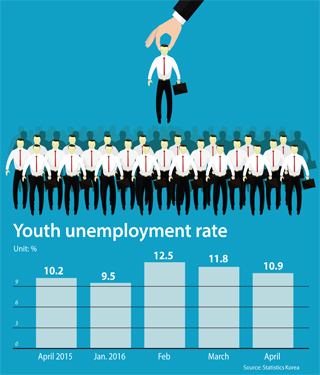Joblessness among youth grows

This is a decrease of 0.9 percentage points from the previous month but is historically a record rate for April. The overall unemployment rate, however, was 3.9 percent in April, down 0.4 percentage points from the previous month.
“The number of unemployed aged 25 to 29 rose 39,000 in April from a year earlier,” said Shim Won-bo, a director at Statistics Korea, “while the number of unemployed aged 20 to 24 dropped by 7,000. The increased rate for youth is mainly due to a spike among people in their late 20s.”
Youth unemployment reached its highest level in February at 12.5 percent and remained in the double digits in March at 11.8 percent. The 10.9 percent rate for April is the highest since 1999, when the government started compiling such data, and it clearly shows that young people have greater competition than previous generations.
Furthermore, Korea’s youth unemployment rate is higher than in other developed countries. The United States recorded a 9.9 percent youth unemployment rate in April. In Japan, the rate was 6.9 percent in March, while in Germany, it was 7.2 percent.
By region, Incheon recorded the highest unemployment rate at 5.2 percent. Jeju’s rate was 1.8 percent, the lowest in the nation, and Seoul recorded 4.4 percent in April.
The economically active population in April was 27.22 million, up 270,400, or 1 percent, from the previous year. The employment-to-population ratio remained unchanged from the previous year at 60.3 percent.
And as employment among males has fallen, it has risen among females, Statistics Korea reports, noting that the employment rate for males was 70.9 percent while that of females was 50.1 percent in April.
The number people who are economically inactive but are attending private institutes, such as those teaching foreign languages in order to help people secure jobs, is 637,000, an 8.1 percent rise from the previous year.
As of April, the total number of employees nationwide stands at 26.15 million, up 252,000 from last year largely due to an increase in the number of seniors adults who are working. There were 206,000 more people aged 60 and over who were working as of April compared to the previous year.
On the other hand, the number of people in their 30s who are working dropped by 22,000 while the numbers of those in their 40s dropped by 52,000 during the same period.
Hospitality, restaurants and service sectors hired more employees, while the number working in the retail and manufacturing industry fell.
“The fall in exports pulled down the rate for manufacturing industry,” said Kim Ih-han, a director at the Ministry of Strategy and Finance. “We expect that the labor market will recover in near future as the government continues to work hard to encourage investments in newly developing industries and designate regulation-free zones around the country.”
In fact, the government announced last month some of the specifics of a plan to expand work possibilities for young people and women, including pregnant women.
The ministry said it will help former interns who are hired at small and midsize companies build up at least 12 million won ($10,251) in savings within two years through government funds. Moreover, the ministry decided to extend the due date on student loans for some people working at small and midsize companies and to raise the amount of monthly financial support for women on maternity leave from 200,000 won to 300,000 won.
BY KIM YOUNG-NAM [kim.youngnam@joongang.co.kr]










with the Korea JoongAng Daily
To write comments, please log in to one of the accounts.
Standards Board Policy (0/250자)